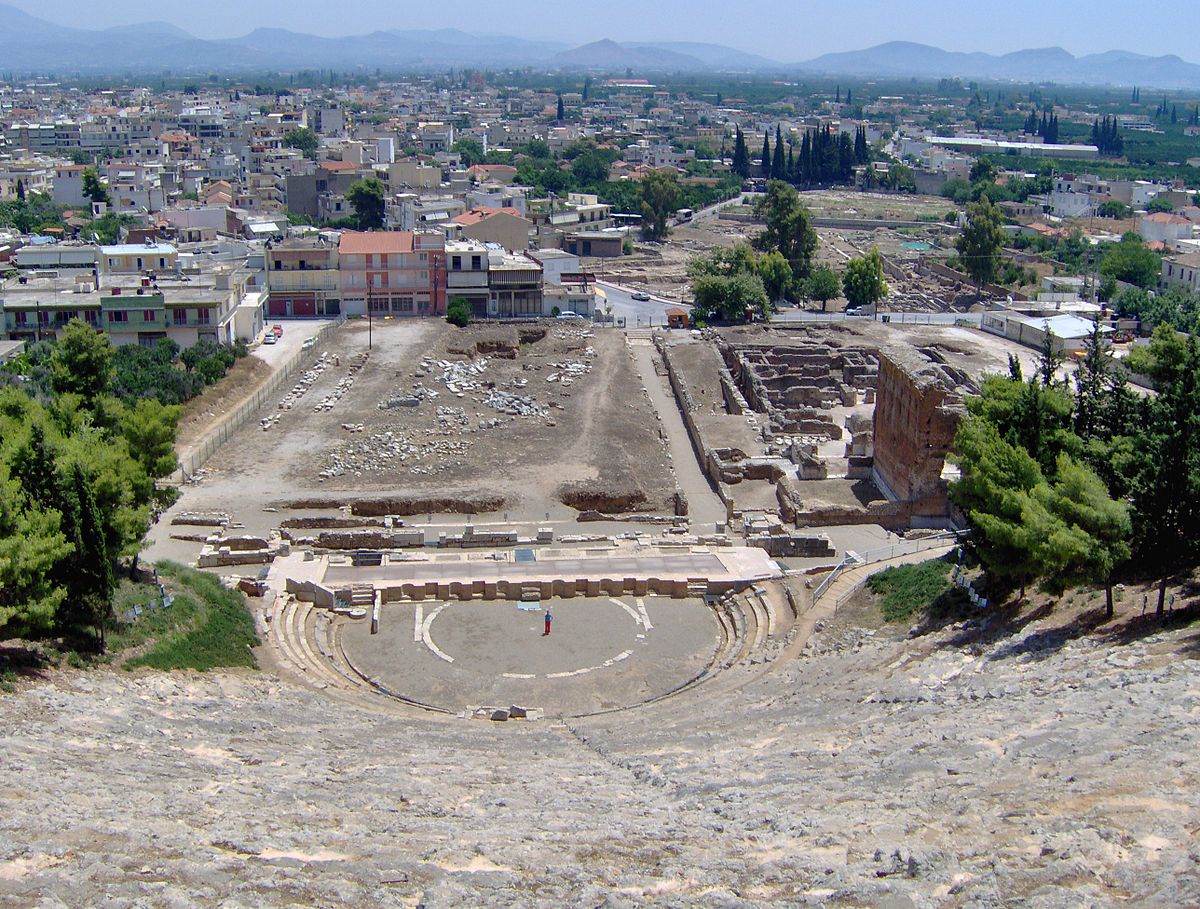Argos (; Greek : Άργος ; Ancient Greek : Ἄργος ) is a city in Argolid, in the Peloponnese, Greece, and is one of the oldest continuously inhabited cities in the world. It is the largest city in Argolid and the main centre of the area.
Following local government reform in 2011, it became part of the municipality of Argos-Mikines, which is a municipal unit. The municipality has an area of 138.138 km2. It is 11 km from Nafplion, which was its historic port. Settled in deepest antiquity, Argos has been continuously inhabited, at least as a major town, for the last 7,000 years. The city is part of the network of Europe’s oldest cities.
The inhabitant of Argos is known as Argive (Greek : Ἀργεῖος). However, the term is also used to refer to the ancient Greeks who commonly attacked the city of Troy during the Trojan War; a term more commonly used by the Homeric bards.
Today, many ancient monuments can be found in the city. Agriculture is the backbone of the local economy.
History of Argos, Achaea
The area of the modern ancient city of Argos appears to have been one of the most densely populated places in Greece, often considered one of the oldest cities, and archaeological evidence suggests that it was founded in the eighth millennium BC. Argos is thought to have been founded by the Pelasgian king Inachus or his son Phoroneas, who gave it its name, until his son Argus named it after himself when he came to power. The city then gave its name to the fertile plain and peninsula on which it stands. The original Pelasgic population of Argos seems to have been replaced at some point by the Achaeans, who were then displaced by the Dorians during the migrations around the 13th century BC. Argos is believed to have been the birthplace of the Macedonian dynasty of Argead, founded in the 8th century BC, of which Alexander the Great was later a member.
Argos, along with Sparta, was one of the dominant powers in the Peloponnese. After defeating the Spartans at the Battle of Gysia in 669 BC, the city came to eclipse Sparta for a time. This period of dominance ended after the costly defeat of the Spartans at the Battle of Sepea in 494 BC. This led to a period of stagnation and the transition of Argos to democracy. It also seems to have influenced Argos’ failure to join the Panhellenic alliance against the Persians in 480 BC, which greatly diminished the city’s reputation among the Greeks and led to accusations that they had been bribed by the Persians to maintain neutrality. In the following years, Argos consolidated its power in Argolid, destroying Mycenae in 468 BC and probably many other settlements around the same time.
Argos formed an alliance with Athens and Thessaly against Sparta in 461 BC, but after 10 years the alliance broke up, probably partly because the Argives were unwilling to commit significant forces to the war effort. Around 460 BC. The Nemean games moved temporarily to Argos, which hosted them for a time, but then disposed of them. At the outbreak of the Peloponnesian War in 431 BC, Argos initially maintained neutrality, but after the Peace of Nicaea formed an alliance against Sparta, which eventually included the support of Athens. A few years later, at the Battle of Mantinea in 417 BC, the alliance suffered a heavy defeat at the hands of Sparta, and the Spartan oligarchy was able to briefly seize power in Argos. Argos continued to periodically support the various entities fighting against Sparta.
During the Macedonian hegemony in Greece, Argos remained unoccupied but changed from democratic to tyrannical rule. It became the target of Pyrrhus of Epirus after the failed attempt to place Cleonius on the Spartan throne in 272 BC, when Aristeus of Argos asked the general for help in overthrowing the Argos government. Aristeus opened the gates to Pyrrhus by night, but the Argosian militia, supported by a nearby Macedonian army and a Spartan contingent, was able to oppose the deception. As a result of the defeat, Pyrrhus was killed, possibly by a fall or by being thrown from a tile, according to some sources. In 270 BC The Nemean games were moved permanently to Argos. At first, Argos supported Antigonus against the Achaean League, but after a series of Achaean successes it joined the league in 229 BC.
After the Macedonians allied with Hannibal against Rome, and Rome essentially supported the Aetolian League as an intermediary against the Macedonians, Argos and the rest of the Achaean League states allied with Macedonia against the Aetolian League and its allies, including Sparta. After the end of the Aetolian War in 217 BC, the Romans appealed to the Peloponnesian states outside the Achaean League to support Rome against Macedonia, including Sparta, and hostilities between Sparta and Argos resumed. By the beginning of the Second Macedonian War in 200 BC, the situation had changed again, with Sparta supporting Macedonia and the Achaean League, under pressure, supporting the Romans.
After the Achaean League sided with Rome, the Macedonians were left with only Corinth. Unhappy with the Macedonian betrayal, after the Macedonian general Philocrates lifted the Roman siege of Corinth, the Argives revolted and, with the help of the Macedonian general, sided with the Macedonians and expelled the Achaean garrison. Unable to maintain their own garrison at Argos in the face of the impending Roman attack in 198 BC, the Spartans were given the task. After taking possession of Argos, the Spartan king Nabis quickly negotiated with the Roman proconsul Flaminius to surrender the city to the Romans in exchange for negotiations to end hostilities between the Spartans and the Achaean League. The fate of Argos was debated, but it remained under Spartan garrison until the end of the Second Macedonian War in 197 BC.
After the war, Flaminius is known to have promised to secure the freedom of the Greeks in Isthmia and guaranteed that the Romans would leave Greece without leaving a garrison. However, Argos remained under Spartan control, which caused some concern among the other Greek states. The Romans offered to agree on a course of action, but refused to comment on the legitimacy of the occupation. The Achaean League accepted the offer and, with Roman military support, began the violent eviction of the Spartan occupation under the command of Pythagoras (not the famous mathematician), who was both son-in-law and brother-in-law of Nabis. Despite the attempted revolt in Argos, the Achaean Roman army decided to put direct pressure on Sparta, which led to the diversion of part of the Argos garrison and allowed the Argives to expel the remaining Spartans in 195 BC. Argos was then restored as a member of the Achaean League until it was dissolved following the Roman conquest of Greece.
At the time of the Roman conquest, or shortly before, Argos was one of the largest cities in Greece, with a population of up to 100,000, divided equally between citizens and non-citizens. The city flourished until the 3rd century AD, when, like many other Greek cities, it was increasingly invaded by barbarians. Argos was one of the cities sacked by the Heruls in 267. Argos seems to have suffered again during the Visigothic invasion around 395.
Archaic Argos
Argos experienced its greatest period of expansion and power under a vigorous 7th century BC ruler, Phaedo. Under Phaedo, Argos regained power over the cities of the Argolid and challenged Spartan domination of the Peloponnese. Spartan dominance is believed to have been broken after the Battle of Gyssia in 669-668 BC, in which the forces of Argos defeated the Spartans in a battle of hoplites. At the height of its power, the city had a school of pottery and bronze sculpture, pottery workshops, tanneries and clothing manufacturers. The city also hosted no fewer than 25 festive events, as well as a regular exhibition of local produce. A sanctuary dedicated to Hera was also found on the site where the monastery of Panagia Catekrimeni stands today. Phaedo also spread Argosian influence throughout Greece, wresting control of the Olympic Games from the people of Elyda and appointing himself organiser during his reign. Phaedo is also believed to have introduced weight reforms and standard measures in Argos, a theory supported by the discovery of six iron “spits” in the Geraion of Argos, possibly the remains of Phaedo’s dedication.
Classical Argos
In 494 BC, Argos suffered a crushing defeat at the hands of its regional rival Sparta. The Battle of Sepea. Following this defeat, Herodotus reports that the city suffered stagnation. The political chaos is thought to have led to a democratic transition in the city. Argos did not participate in the Greek alliance against the Persian invasion of 480 BC. This led to a period of diplomatic isolation, although there is evidence of an alliance between Argos and Tegea until 462 BC.
In 462 BC, Argos established a trilateral alliance with Athens and Thessaly. However, this alliance was somewhat dysfunctional, and it is believed that the Argives made only minor contributions to the alliance at the battle of Oenoe and Tanagra. For example, it is believed that only 1000 Argosian hoplites fought alongside the Athenians at the battle of Tanagra. After the defeat of the allies at Tanagra in 457 BC, the alliance began to disintegrate, leading to its dissolution in 451 BC.
Argos remained neutral or an ineffective ally of Athens during the Archidamian War between Sparta and Athens. Argos’ neutrality increased its prestige among other Greek cities, and Argos used this political capital to organise and lead an alliance against Sparta and Athens in 421 BC. This alliance included Mantinea, Corinth, Elida, Thebes, Argos and finally Athens. However, this alliance fell apart after the defeat of the allies at the Battle of Tegea in 418 BC. This defeat, combined with Epidaurus’ incursion into Argolid, led to political instability and a possible oligarchic coup in 417 BC. Although democracy was restored within a year, this coup permanently weakened Argos. This weakening led to a loss of power, which in turn caused a shift of the commercial focus from the Ancient Agora to the eastern part of the city, bounded by the Danau and the Agiu Constadina.
Argos played a minor role in the Corinthian wars against Sparta, and briefly considered joining Corinth to form an enlarged state of the Argolid. Within a short period the two cities were united, but Corinth quickly rebelled against Argos’ domination and Argos returned to its traditional borders. Thereafter, Argos remained a secondary power in Greek affairs.
Democracy in classical Argos
Argos was a democracy for most of the classical period, with a brief lull between 418 and 416. Democracy was first established after the disastrous defeat of the Spartans at the Battle of Sepea in 494.
The Argosian democracy comprised an assembly (called the aliaiaia), a council ( bola) and another body called the Eighty, whose exact functions are unclear. Judges served a six-month term, with some exceptions, and were reviewed at the end of their term. There is some evidence that ostracism was practised.
You may also like:

